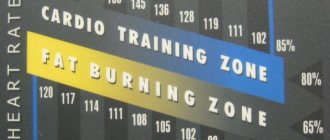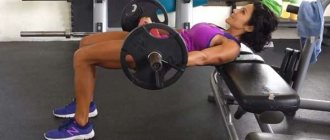Scientific research has revealed that the main cause of high mortality in Russia is cardiovascular diseases. They make up 53% of the total share of pathologies leading to death. Almost all of them are caused by poor lifestyle and genetic predisposition. And although people have not yet learned how to influence heredity, they can prevent or reduce the influence of these factors on the condition of the heart and blood vessels. The most accessible ways are cardio training and proper nutrition.
Cardio training is low-intensity physical activity and is necessary for:
- strengthening heart muscles;
- improving the functioning of the cardiovascular system;
- strengthening general health;
- acceleration of metabolism;
- burning fat.
There are many types of cardio training, each person can choose an option based on their strength and health status.
Types of Cardio Training
You don’t have to visit a fitness club to exercise; training can be done outdoors or at home.
- Run. This is one of the best physical activities, it is effective in any form, simple and accessible to everyone. You can select one of the load types. The first is a slow run at a constant speed for 20 minutes. The first few times it is better to limit yourself to 10 minutes, gradually increasing the time. The second is interval running, that is, alternating 1 minute of fast running with 3 minutes of slow running. Total time – 15–20 minutes.
- Cycling. The best option is cycling in the fresh air, provided the weather is good. During the rainy and cold season, you can use an exercise bike. Riding uphill is a great workout for strengthening your heart muscle. The optimal practice time is 25 minutes at a slow pace.
- Swimming. One effective way to strengthen your heart muscle is to swim breaststroke, but other techniques are also effective. The main condition is the intensity of movements. Lesson time is 25–30 minutes; swimming styles can be changed during training.
- Walking. This type of workout can be done anytime and anywhere. You should not forget to actively work with your arms - when walking, you need to bend and unbend them. The duration of the session depends on your health condition; it varies from 30 minutes to an hour. In addition to strengthening the heart muscle, walking normalizes digestion.
- Stepper. This is the name of a type of exercise that simulates climbing stairs. When doing this, you should pay attention to which leg is the first to step on the step; this leg is the one that receives the emphasis. You need to allocate 10 minutes of emphasis on the right leg and the same on the left.
- A set of exercises. It can be done at home and does not require special equipment:
- from a standing position, do 5 lunges to the side, first with the right, then with the left leg;
- legs together, arms down along the body. When inhaling, raise your arms, stretch your whole body up, stand on your toes, when exhaling, return to the starting position, perform the exercise 3-5 times with a ten-second interval;
- lie on your back, spread your arms to the sides. As you inhale, lift one leg, hold for a few seconds, while exhaling, lower it, repeat the exercise with each leg 4 times.
If you don't have time to go to the gym, you can go for a run or just take an energetic walk. This will not require a lot of time, but the result will pleasantly surprise you.
How to achieve a calorie deficit?
There are two ways to achieve a negative energy balance: reducing your calorie intake and exercising. During cardio, calories are burned and hence can be subtracted from your total intake.
The methods have their pros and cons.
Let's say that in order to make up for the deficiency, you need to subtract 500 kcal from your daily requirement. You can do this by skipping a 500-calorie meal or eating and then exercising to burn off the excess.
Before you decide how much cardio you need to do to lose weight, it's important to understand the basics of how your body functions.
“500g of fat contains 3500 kcal and therefore you need to burn 3500 kcal to lose 500g per week.”
Here's what you should do in terms of workouts per week. If you want to burn 3500 kcal per week, there are 3 options:
- Do 30 minutes of cardio per day and eat a moderate calorie diet: If you're not active, you won't be able to eat much food until you reach a calorie surplus. But you don't have to exercise to achieve a calorie deficit, suitable for those who don't like to exercise - but you may be very hungry.
- Do cardio 5 days a week and lightly restrict your calories: the more you exercise, the more you can eat, and by staying in a calorie deficit, you can eat more each day. You will become healthier and slimmer.
- Do cardio 1 to 3 days a week for 30 minutes and stick to a moderate calorie diet: eat less and exercise more. You can lose weight even faster by exercising on an empty stomach, but you run the risk of getting sick if you do long-term cardio workouts and consume few calories.
The third option may appeal to you, but this option becomes overwhelming very quickly.
Important Point: The key to losing weight is achieving a calorie deficit by cutting food intake or burning it through exercise, or a combination of the two to increase results.
Workout program for home and gym
If cardio training is not performed regularly, it will be of no use. Excessive load will also not lead to a positive result. It is for this purpose that special training programs are developed:
- fartlek - designed for physically strong and fit people. In this program, the speed and tempo of the load alternate; the alternation does not have to be sequential - high intensity can be replaced by low speed of movement and short periods of recovery;
- Continuous cardio training is prolonged physical activity without rest, such as running at the same speed without rest or long cycling;
- interval cardio training - this type of activity is more difficult and intense than the previous one. It involves alternating levels of difficulty, for example, long running at different speeds. During interval training, a short rest is possible;
- super circuit training is a rather complex option that involves alternating intense training with aerobic exercises with weights. This scheme helps maintain muscle mass in tone and promotes rapid weight loss;
- Cross training is alternating between different types of cardio, such as 20 minutes of running, then 10 minutes of vigorous exercise on a stationary bike, and 10 minutes on an elliptical machine. Cross-training involves a variety of physical activities that can be varied daily.
These are the most commonly used programs recommended by experts.
It is important to know! Combining cardio training with proper nutrition can achieve the best results.
Interval Cardio
Interval cardio is the best solution for those who want to quickly lose extra pounds while maintaining muscle mass. Such training has a positive effect on the process of fat oxidation and blocks the production of special enzymes that provoke their deposition.
In order to replenish metabolic balance, the body continues to actively consume calories throughout the day after the end of interval training, preventing them from being deposited as fat.
This type of training consists of high-intensity intermittent exercise, in which high loads alternate with short periods of rest and lower-intensity exercise. The duration of the intervals varies from 7-8 seconds to several minutes. They must be calculated individually, gradually increasing the intensity of the load. The following equipment will be useful for interval cardio training:
- treadmill;
- a simulator simulating manual rowing;
- elliptical trainer;
- jump rope
An example of effective interval training is the following algorithm: after a mandatory three-minute warm-up, over the next half hour, alternate intervals of fast running (1-2 minutes), running with acceleration (8-12 seconds) and moderate-intensity exercise (no more than 30 seconds). ). The presence of intervals in the case of low intensity of the training process does not make sense, so interval cardio should be practiced only if you are ready to give it your all.
When and how best to do cardio training
It depends on the individual characteristics of the human body. Experts say that the best time to exercise is in the morning, when the body is not tired and full of unspent energy. There are people who feel better in the afternoon or evening than in the morning, or who do not have the opportunity to exercise in the morning.
The choice of physical activity depends on the goal being pursued - if a person wants to lose weight, then it is better to do cardio exercises before strength training. To increase muscle mass, cardio exercises should be performed after strength training. If you choose a combined option, that is, alternating strength exercises and cardio exercises, you need to remember that such a workout should not last more than 20 minutes. Otherwise, the body will be exhausted for the whole day.
To strengthen the heart muscle and not harm it, you should not overdo it; three classes a week will be enough, sometimes you can do four classes, the class time is from 30 to 60 minutes. The main indicator of cardiac training is pulse. The whole point is to maintain a certain indicator for 20 minutes. Each person has individual maximum indicators - it depends on the age and condition of the body.
The lesson should be carried out progressively:
- the first 3–5 minutes – warm up the muscles;
- the next 10 minutes – the load increases to the optimal level;
- the next 15–20 minutes – the training is under full load;
- the next 10 minutes – the load gradually decreases.
If you feel unwell, the duration and frequency of exercise should be reduced or canceled altogether.
Energy balance is the key to success
The secret of the industry is that no one wants you to know that if you create a calorie deficit, that is, you eat less than you burn, then you will lose weight... and if you create a surplus, you will gain weight.
When you consume too many high-calorie foods, your body stores energy in fat cells in preparation for starvation. This is called a calorie surplus or positive energy balance.
The problem is that the hunger strike will never happen and you will continue to accumulate more and more. And this is definitely bad.
On the other hand, if you eat fewer calories than you burn, you will be given the master key to your fat cells, opening them up and unlocking that extra energy to make up the difference.
This is called a calorie deficit or negative energy balance. And this is the key to fat loss.
Distribution of physical activity
Cardio training brings good results, but only in cases where the load corresponds to age, level of training and health status. The safe heart rate zone (SPZ), within which exercise does not cause harm to a person, is different for everyone.
In young, healthy people, the level of physical fitness is tested by doctors using stress tests. For this, a bicycle ergometer is used - this is riding on a machine with varying resistance. Testing can also be done on a treadmill - a treadmill that allows you to run and walk at a given speed and incline.
During testing, all indicators are recorded:
- arterial pressure;
- Heart rate;
- ECG.
Based on the results obtained, the following load calculation method is used:
- ZPB = heart rate max × (0.65…0.8);
- Heart rate max = 220 minus age.
For people suffering from cardiovascular diseases, a stress test is performed on a bicycle ergometer or treadmill. During the test, the load is gradually increased until chest pain or changes in the ECG occur, at which point the heart rate threshold is set. ZPB for cores is calculated as follows:
FTB = heart rate threshold × (0.6–0.8).
Thanks to tests, it is possible to determine a safe intensity of physical activity.
How to do cardio correctly
The time for cardio exercise is selected on an individual basis, but most experts recommend conducting such training in the morning. It is during this period that the body is at its peak.
If you start from eating, then proceed according to this scheme:
- On an empty stomach in the morning, if the cardio load is low and up to 15 minutes in time. To put it roughly, this will be a regular morning exercise.
- Full, after 1.5 hours from eating. These can be intense workouts where you push yourself to the limit.
The main rule for successful training is to focus on your heart rate (heart rate). In order to calculate the maximum allowable heart rate during training, you should use the following formula:
- For women: subtract your own age from 214;
- For men: subtract your own age from 220;
It is not worth increasing the intensity of the training process to maximum levels, since fat begins to be burned at a heart muscle contraction frequency equal to 65-70% of the maximum permissible threshold.
At the beginning, the duration of the workout should vary between 15-30 minutes. However, during this period, the body primarily consumes glycogen contained in the muscles and liver, and only after that it turns to fat reserves. Therefore, the total time spent on training should tend to be an hour a day.
Recommendations for implementation
One of the main components of a successful training is the attitude and motivation of the athlete.
- It is worth periodically alternating the pace and performing several different exercises in one day.
- Properly selected music or a movie can improve your mood and take your mind off thoughts of fatigue.
- On days of strength training, it is not recommended to perform prolonged cardio exercise.
- If it is not possible to exercise outdoors, it is recommended to ventilate the room, providing access to fresh air during the training process.
- The best sportswear for such activities is the one made from natural, breathable fabrics. If you run outside in cool weather, read this article.
How to breathe correctly during exercise
It is very important to breathe properly during cardio training. It depends on what type of physical activity a person is engaged in:
- if flexibility exercises are performed, inhale when expanding the chest, exhale when compressing it;
- Inhalation during strength exercises should be done when the load on the muscles is minimal, and exhalation should be done at the moment of greatest muscle tension;
- With intense walking, running, or cycling, the need for oxygen increases sharply. If breathing becomes erratic, normal ventilation of the lungs is disrupted. Therefore, it is especially important to monitor proper breathing. Each inhalation and exhalation at a moderate speed should occur on the third or fourth step, at a faster speed - on a count of one or two;
- while swimming, proper breathing depends on the style - if a person swims breaststroke, inhalation is done while raising the head above the water level. If it is a crawl, then the inhalation should occur at the end of the stroke, when the mouth is above the surface of the water, the exhalation should go out into the water.
If at the beginning of training you cannot breathe correctly, do not be upset. You just need to put in a little effort, it will definitely pay off.
Myth about how long a cardio workout lasts
You've probably heard that cardio needs to be done for at least 30-40 minutes so that the body switches to burning fat. Allegedly, glycogen burns for the first forty minutes, and then the magic switch switches to the “burn fat” position.
There is no magic switch in our body that after 40 minutes of cardio begins to burn fat
However, from a physiological point of view, this myth is very easy to refute. Cardio workouts do not always use glycogen as an energy source.
Let's look at a simple example: when you run slowly, at a constant pace and without shortness of breath, the body uses up intramuscular fat and fatty acids, which freely circulate through the blood, and during physical activity are transferred to the muscles, where they are oxidized under the influence of oxygen, providing energy to the working muscle. This is aerobic work, meaning the body has enough oxygen to provide energy to the muscles.
Another type of exercise is anaerobic. When you run fast, the body does not have time to receive enough oxygen to oxidize fatty acids, so glycogen (carbohydrates) is activated. It is a faster fuel and can provide energy to the muscle when it lacks oxygen. However, anaerobic work produces byproducts that acidify muscle cells, causing us to become fatigued.
Now comes the fun part - fat burning starts with 1 second of cardio! Our body doesn't just burn fat during cardio—it does it all the time.
And here's why - you are now sitting and reading the article. Your body spends energy on various vital processes, including maintaining posture, functioning of organs, and the brain. All these processes require energy supply.
It’s very easy to draw an analogy with a car; our body is the same mechanism that needs energy (gasoline). However, it works (“started”) constantly, so it always consumes fuel. When we lie down, less fuel is consumed, when we walk, more fuel is consumed, and when we run, energy consumption increases.
Thus, the idea that fat is consumed only after 40 minutes of training is a myth. The body has a flexible mechanism that allows you to consume glycogen only at a certain intensity of training; in other cases, fat is always and everywhere consumed, even after 1 minute of cardio.
How to exercise properly if you have heart disease
The concept of “cardio training” is different for all people. For healthy people, this includes intense running, swimming, aerobics, and cycling. And for people with diseases of the cardiovascular system, bending over, raising arms and legs, and walking in place is already considered cardio training. Before starting classes, the patient must purchase a heart rate monitor that will determine heart rate.
The possibility of conducting cardio training should be discussed with your doctor, since its duration and intensity will depend on the diagnosis:
- for hypertension, the optimal types of cardio exercises are walking, exercises in a standing, sitting and lying position, cycling;
- for atherosclerosis, recommended types of cardio training are walking, swimming, cycling, weight-bearing exercises;
- for coronary heart disease outside the acute stage, walking in place and physical therapy are recommended.
The time interval and frequency of classes per week is determined by the patient’s condition. You need to start with 20 minutes and three times a week, gradually increasing your training to 160 minutes a week, divided into 3 days. For patients with inflammatory diseases of the cardiovascular system, even the lightest exercise is strictly prohibited.
Recommendations from experts
Here are some basic tips for losing weight. Consult with a qualified nutritionist or certified fitness trainer to come up with a workout plan that fits your goals and schedule.
When it comes to recommendations, there is no better place than the American College of Sports Medicine.
Why? A close-knit group of expert physiologists, sports scientists and medical personnel know what they are talking about. And they are responsible for conducting all the research on a topic related to health and fitness, and for providing educational and practical guidance that will help you achieve your goals.
The college's recommendations are as follows:
- 150 minutes of exercise per week at an average pace;
- 5 days a week for 30-60 minutes (moderate) or 3 days a week for 20-60 minutes (vigorous);
- Work at an intensity between 55% and 95% of your maximum heart rate.
Choose any exercise you enjoy - running, swimming, cycling - and gradually increase the duration and intensity.
Likewise, Mahri Relin, a certified personal trainer, said she encourages her clients to do four to five cardio workouts per week, each lasting 30 to 45 minutes.
Celebrity fitness trainer Katherine Greiner recommends 30 to 45 minutes of cardio per day or 20 minutes of high-intensity interval training (HIIT).
It's important not to overdo it. Relin stated, “Strong cardio workouts can cause extreme hunger, and the calories burned are replenished, if not exceeded.”
"Too many repetitions of cardio can lead to what's called 'adrenaline fatigue,' which can lead to weight gain," Greiner added.
Follow your weight loss plan
If your goal is permanent fat loss, then you need to burn enough calories to get results. As mentioned earlier, to lose 500g per week, you need to create a deficit of 3500 kcal, in other words you need to burn 3500 more than you ate. A 30-minute workout on a flat surface will burn about 120 calories. Thus, to burn 1 kg by walking, you need to walk 2 hours a day.
Don't worry. Nobody forces you to exercise 2 hours every day. The best way to lose weight is to create a calorie deficit through exercise and reducing your calorie intake.
For example, over the course of a week you can reduce the calorie content of your food by 250 kcal by replacing mayonnaise with mustard and fruit yogurt with light yogurt. In addition, you can burn an additional 250 per day with an hour of walking or half an hour of jogging.
Cardio training is one of the components of losing weight. You need to change your eating habits correctly and follow an exercise program.
Increase weight loss
Work in your target heart rate zone most of the time to lose weight. Remember: if you're "out of shape," as people like to say, even training at 50 percent of your maximum heart rate can help improve your fitness level.
You may have heard that slow-paced workouts are more effective for weight loss than intense-paced workouts. In fact, many of the cardio machines at your gym are programmed to "burn fat" and keep you at a slow pace. But this is misleading. It turns out that the concept of a fat-burning zone is no more real than the twilight zone.
During low-intensity aerobic exercise, the body converts fat into its main energy resource.
As you approach the critical point, the body begins to use a lower percentage of fat and a higher percentage of carbohydrates, another source of energy. However, Raising the Pace allows you to burn not only more calories from fat, but even more calories in total.
So, if you roller skate at a slow pace for 30 minutes, you can burn about 100 calories - about 80 percent of them from fat (that is, 80 kcal). But if you ride the same amount on hilly terrain, you can burn 300 kcal - 30 percent of it from fat (that's 90 kcal).
So at a fast pace you burn twice as many calories and 10 more calories of fat.
Of course, fast-paced, high-difficulty workouts aren't always better. If you're just starting out, you probably won't be able to handle training at a faster pace without regretting it. If you train at a slower pace, you'll be able to do a lot more cardio, so you'll end up burning more calories and fat.
Exercises that help you burn more calories
"Increase your workout productivity and burn 1,000 calories per hour." These types of advertisements can be seen on treadmills, stair machines, and other exercise equipment. And it is true. You can burn 1000 kcal/hour doing exercises on these machines if the machine is set to maximum and you have bionic legs.
If you are a beginner, you will hold on for about 30 seconds at this pace and burn 8.3 calories, after which the paramedics will take your weakened body away on a stretcher.
There is no better approach than this: choose an activity that you can do for a long period of time, say 10-15 minutes. Of course, running burns more calories than walking, but if running wears you out after a few meters or your knees start to hurt, then it's better to walk.
The following table shows how many calories you can burn by doing popular exercises. The number of calories depends on the intensity of the workout, weight, muscle mass and metabolism.
In general, beginners can burn 4 to 5 calories per minute of exercise, while a person in excellent shape can burn 10 to 12 calories per minute.
The table shows games such as basketball and volleyball. Exercises like these aren't strictly aerobic, but they can give you a great workout and promote well-being and weight loss.
These numbers refer to people weighing 68 kg. (If you weigh less, you'll burn a little less; if you weigh more, you'll burn a little more.
| Number of calories burned | ||||
| Exercise | 15 minutes | 30 min | 45 min | 60 min |
| Aerobic dancing | 171 | 342 | 513 | 684 |
| Basketball | 141 | 282 | 432 | 564 |
| Bicycle 20 km/x | 142 | 283 | 425 | 566 |
| Bicycle 25 km/h | 177 | 354 | 531 | 708 |
| Bicycle 29 km/h | 213 | 425 | 638 | 850 |
| Boxing | 165 | 330 | 495 | 660 |
| Circuit strength training | 189 | 378 | 576 | 756 |
| Cross country skiing | 146 | 291 | 437 | 583 |
| Skiing | 105 | 210 | 315 | 420 |
| Golf | 87 | 174 | 261 | 348 |
| Rollers | 150 | 300 | 450 | 600 |
| Jumping rope, 60-80 jumps per minute | 143 | 286 | 429 | 572 |
| Karate, taekwon-do | 180 | 360 | 540 | 720 |
| Kayaking | 75 | 150 | 225 | 300 |
| Racquetball | 114 | 228 | 342 | 456 |
| Rowing machine | 104 | 208 | 310 | 415 |
| Running 16 km/h | 183 | 365 | 548 | 731 |
| Running 13 km/h | 223 | 446 | 670 | 893 |
| Ski simulator | 141 | 282 | 423 | 564 |
| Rowing | 152 | 304 | 456 | 608 |
| Freestyle swimming, 32 meters/min | 124 | 248 | 371 | 497 |
| Freestyle swimming, 45 meters/min | 131 | 261 | 392 | 523 |
| Singles tennis | 116 | 232 | 348 | 464 |
| Tennis "doubles" | 43 | 85 | 128 | 170 |
| Climber training | 188 | 375 | 563 | 750 |
| Walking on flat terrain, 32 km | 60 | 120 | 180 | 240 |
| Hilly walking, 32 km | 81 | 162 | 243 | 324 |
| Walking on flat terrain, 25 km | 73 | 146 | 219 | 292 |
| Hilly walking, 25 km | 102 | 206 | 279 | 412 |
| Water aerobics | 70 | 140 | 210 | 280 |











